MORE THAN A MOTOR RACING CIRCUIT, THE CITY OF LE MANS IS ONE OF THE BEST KEPT SECRETS OF FRANCE
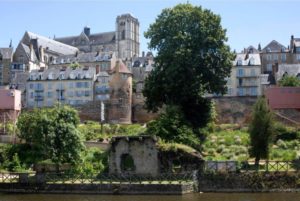
Mention the town of Le Mans, and many of us would probably first think of the motor racing circuit famous for its gruelling 24 hr. endurance race held every year in June. The majority of visitors at that event watch the race, enjoy the local cuisine and the friendly bars and leave. Amazingly, most of them never realise that there is a beautiful old town so close by. The don’t see the Roman ruins, they miss the narrow cobble-stoned streets lined with half-timbered houses, and miss out entirely on the wonderful medieval architecture.
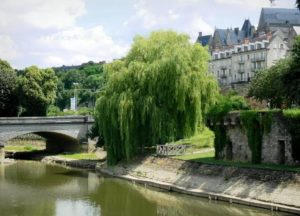
Le Mans is located on the river Sarthe, about an hour’s train ride by TGV S.W. of Paris Gare Montparnasse, making it an ideal day trip. It’s now the capital of the Sarthe département in the Pays de la Loire region. At the confluence of the Sarthe and Huisne rivers, the city lies S.W. of Chartres in the former province of Maine. It’s been designated a ‘City of Art and History’.
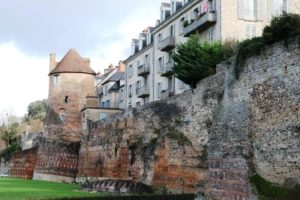
The city, seized by the Romans in 47BC, was within the ancient Roman province of Gallia Lugdunensis, and named Cenomanorum after the local tribe, the Cenomani. A 3rd century amphitheatre is still visible, although the thermae (baths) were demolished during the so-called Crisis of the Third Century—also known as the Military Anarchy or Imperial Crisis—which was a period in which the Roman Empire nearly collapsed, due to barbarian invasions, civil wars, peasant rebellions and political instability. The rubble and stone from the former baths were used by workers building the city’s defensive walls. The ancient wall around Le Mans is one of the most complete circuits of Gallo-Roman city walls to survive, and very distinctive, especially along the river frontage, with its pink mortar and ochre sandstone blocks. Hidden away in some of the medieval houses in the ancient quarter, there are even more Roman remains.
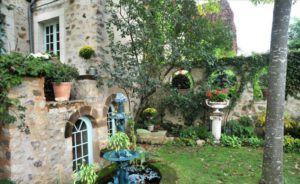
At the end of September, there is a fabulous open garden festival known as ‘Entre Cours et Jardins’. During this time, many of the locals open their doors to the public to show off their beautiful courtyard gardens, and in at least one house, there is an original Roman cellar, complete with a Roman charcoal burner. It’s a town that’s full of surprises! The next festival is 23 & 24 September 2023.
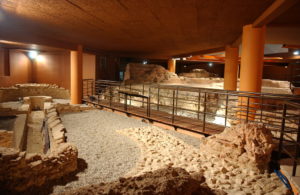
In 1980 the ruins of the Roman Baths, known as the Crypte Archeologique des Thermes Romains, were discovered by accident during the building of the École Supérieure des Beaux Arts. Although they’re still almost hidden from view beneath the school, the remains are clear enough to see each of the individual chambers, as well as the underfloor heating system that were typical of Roman bath complexes. Guided visits only, booked through the main Tourist Office.
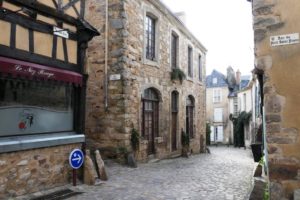
As well as having been a Roman city of some importance, the ancient town of Le Mans was known as Vieux Mans, but was renamed in 2002 to Cité Plantagenêt, in recognition of Le Mans’ place as the seat of the Plantagenets. In 1128 Geoffrey V, Count of Anjou and Maine, married Matilda, granddaughter of William the Conqueror, in the cathedral. Geoffrey died in 1151 and was buried there. Their son, Henry ll, recognised as the first Plantagenet King of England, was born in Le Mans in 1133 in the palace of the Counts of Le Mans (now the Hotel de Ville). Henry married Eleanor of Aquitaine and was the forebear of kings, including Richard the Lionheart. After the death of Richard, his widow, Queen Berengaria of Navarre, was virtually abandoned in France by the Plantagenets. She went to Le Mans in 1204, “where she had found asylum, but not happiness”, and where she obtained the administration of Le Mans and the surrounding territory. She lived the last 25 years of her life in the royal palace of the Counts and was buried in Le Mans, at the Abbey of L’Épau, which she founded in 1229.
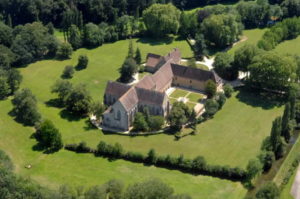
This former Cistercian abbey is located approx. 4.50 kms from Le Mans on the banks of the river Huisne, adjoining the town of Yvré-l’Évêque. Located in a park of some 13 hectares enclosed by a wall, almost all of the abbey’s buildings have survived. You can visit the abbey church, its beautiful chapter house containing the recumbent statue of Queen Berengaria, the dormitory, scriptorium, sacristy, cloister garden and parkland. A listed historic monument, the site has been owned by the departement of Sarthe since 1959. It’s home to the Sarthe Cultural Centre, which regularly hosts temporary exhibitions, conferences and classical music concerts, in particular, the L’Épau Festival in May.

The Abbey and domain are 5 mins. by car, or about 15 mins. by tram from the city centre. Check the abbey’s opening times with the Tourist Office in rue de l’Étoile, a few blocks down from the station, en route to the medieval quarter. This office also has very useful info. for visiting the city–ask particularly for the ‘Plantagenet City route map’.
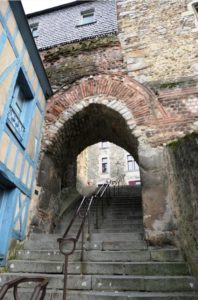
Unlike the medieval quarters of most towns and cities in France, the Plantagenet City of Le Mans is completely separate from the modern day city. In an elevated position, it is a pleasant, restful haven with a totally different atmosphere. From the railway station, buy a tram ticket that takes you straight through to the carpark at foot of the medieval town up on its plateau, with the magnificent Gothic St Julien Cathedral clearly visible from below. To reach the top, the quickest way is to take the stairs from Place des Jacobins, or alternatively, there are footpaths that wind up the slope giving access into the ancient town through gates in the Roman walls.
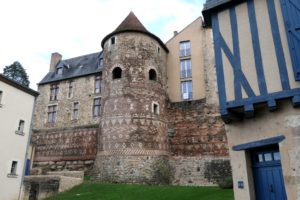
Four of the five original towers of the fortified walls still remain. At one of these, a lovely little medieval-style garden has been created, and within it are some of the stone balls catapulted again the town by the Count of Salisbury during his assault in 1425.
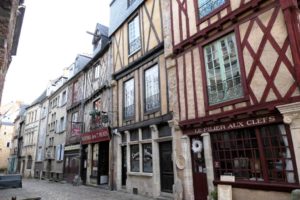
The medieval town has enticing narrow streets lined with stone houses, many with intricate details. There are colombage (timbered) buildings, and the fine slate roofs common to this area.
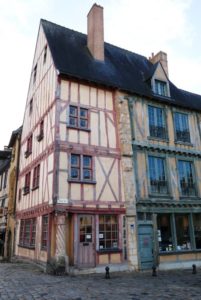
There are numerous half-timbered medieval houses dating from the 14th to 16th centuries, the best known of which is the ‘Maison du Pilier Rouge’ (house of the red column) from the 16th century on the corner of Grand Rue, with its easily recognisable, red-painted timber structure. These carved corner columns are a distinctive feature of the ancient quarter. The Maison du Pilier Rouge is now a visitor information office for the Cité Plantagenêt.
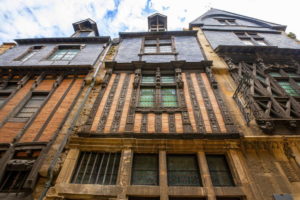
The oldest houses have upper floors that protrude forwards over the lower storeys which served to increase the floor space upstairs and to protect the entrance from rain. The best place to see these is the group of houses along rue de la Reine-Bérengère, where the Maison du Drapier and Maison de la Reine-Bérengère stand either side of the slightly more recent Maison de l’Ave-Maria. The houses with timbered slats, along with intricate stonework, denotes a bourgeoise house of the wealthier inhabitants of the medieval city.
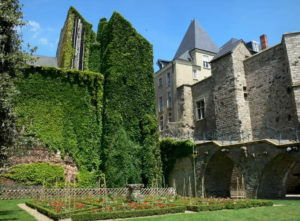
The Royal Palace of the Counts, now the Hotel de Ville, on Place St Pierre is an impressive ensemble of buildings that in part dates back to the 11th-12th centuries.
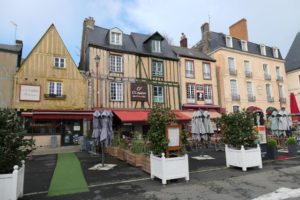
This pretty square is lined with half-timbered medieval buildings now occupied by a number of enticing local bistros such as ‘O’Comptoir des Cocottes’ at no. 10, where we had one of the best lunches we’ve ever had in rural France. Outside, the area seemed rather quiet with few people about–which we assumed was due to the chilly winter’s day of our visit, but when we pushed open the door of this little place, it was buzzing with activity. It seemed that half the town was there for lunch, and we were very lucky indeed to find a table.
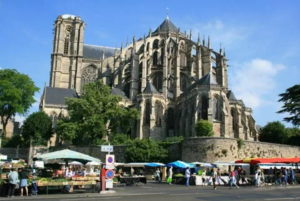
Le Mans is home to several ancient cathedrals, and the most prominent would certainly be the Cathédrale Saint Julien-Le Mans dramatically positioned in the Cité Plantagenêt, overlooking the main town. Its construction dates from the 6th century through to the 14th century, combines a Romanesque nave and High Gothic choir, and is notable for its frescoed ceiling of angels, the quality of its beautiful 12th century stained glass, and dramatic flying buttresses at its eastern end. It also has a number of details borrowed from Chartres cathedral, and is one of the largest cathedrals in France.
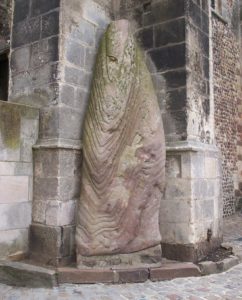
At the main entrance is a stone menhir, which was raised by the prehistoric people who inhabited the region in 4,000-5,000 BC. The menhir, which was a pagan fertility symbol, was saved from destruction by St Julien who came to Le Mans in the 4th century.
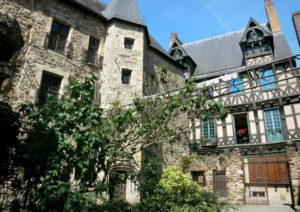
Close to the cathedral, housed in 3 beautiful timber-framed houses, is the Queen Berengaria Museum. This is a museum of the history of Le Mans with a collection of documents and folk art related to the town and the Sarthe departement during the 18th-early 20th centuries, as well as paintings, drawings and furniture.
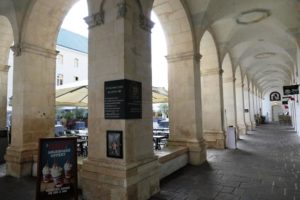
After exploring the Cité Plantagenêt, take a stroll through the charming Place de la Republique, right in the heart of Le Mans. Surrounded by picturesque buildings and adorned with a number of sculptures and fountains, the square is a popular spot for both locals and visitors alike.

There are a number of cafes and restaurants lining the square, making it the ideal spot to rest, relax and people-watch awhile. Also on the square is an architectural gem with a huge dome, the recently restored 17th century Chapelle de la Visitation. A former convent, it has an exquisite rococo interior, very rare in French religious architecture.

Talking about Le Mans, it’s impossible to ignore the event for which the city is world-renowned. There is a museum dedicated to the track and is worth a visit, even for non-petrolheads. The Circuit des 24 Heures du Mans museum covers the history of the track and race, which has been held annually since 1923, and features a range of interactive exhibits as well as over 140 model cars such as Porsche, Ferrari, Jaguar, Audi etc. Visitors can even take a simulated lap of the track in a specially designed car. You’ll find it at 9 Place Luigi Chinetti, about 7kms from the city centre.

It is also possible to visit the circuit: either self-guided, or accompanied by a guide who recounts anecdotes about the race and the big day. You will also discover what it’s like behind the scenes, and visit the Press Room and the podium. Ask for directions at the Tourist Bureau.
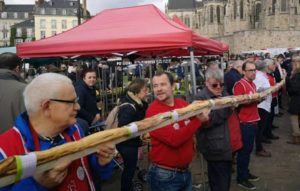
As well as its vivid historical past and that motor race, the city is renowned for its food, especially for Le Mans rillettes, with a smooth texture similar to pâté or terrine. It’s a local speciality, using meat, usually pork, from the leg, thigh, shoulder or rib, rather than offal, as is the case with pâtés and terrines. There are a number of excellent charcuteries in town where you’ll find it.
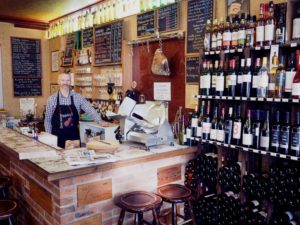
You will discover that wines are produced in the Sarthe region of the Loire. The area is known for Cabernet Franc but particularly Jasnières, a delicate and elegant white that appears on the tables of the country’s top restaurants and also the Élysée Palace. You’ll find an excellent selection at Le Bar à Vin in rue du Cornet.

Le Mans is one of the most rewarding destinations for an easy day trip from Paris, or even for an overnight stay, en route to the Loire Valley. Somewhat unexpectedly, it has so much to offer the visitor, even without mentioning the great motor race!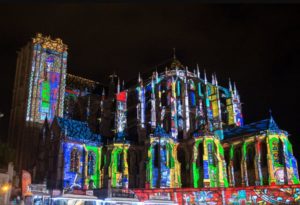
La Nuit des Chimeres light festival held every July to Sept. in Le Mans


Thanks, Cheryl. I might try to factor that into my trip.
Hi Lois,
As I mention in the story, it’s very accessible from Paris, and once you’re there, getting around is easy and indeed, very pleasant. It was simply that we’d not been there before, and read about it somewhere, quite recently, that started us off on our search to find out more. A very rewarding destination, and as far as most visitors to France go–with the exception of those heading to the famous annual car race–totally unknown. A delightful, and very rewarding surprise!
So glad you enjoyed it,
Cheryl
Very interesting – I had no idea there was so much more to
Le Mans.
Hi Nadine,
No, neither did we, until we did a bi of investigating, having read something about Le Mans being known as the City of the Plantagenets. We’d never heard this before, and that started us on the trail. So glad we did!
Cheers,
Cheryl